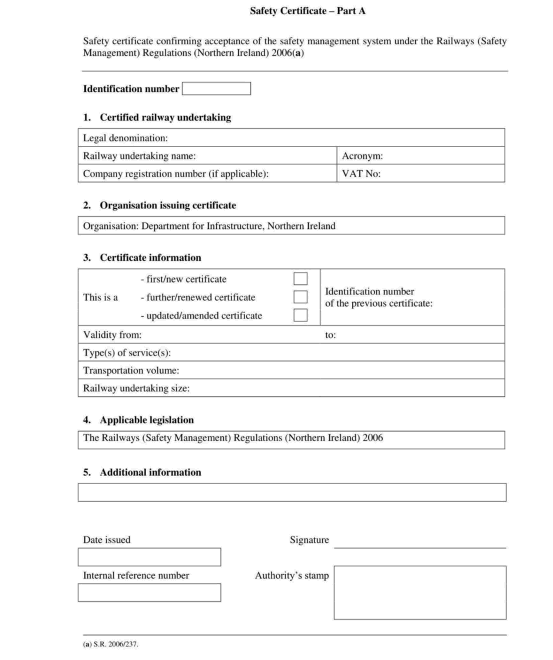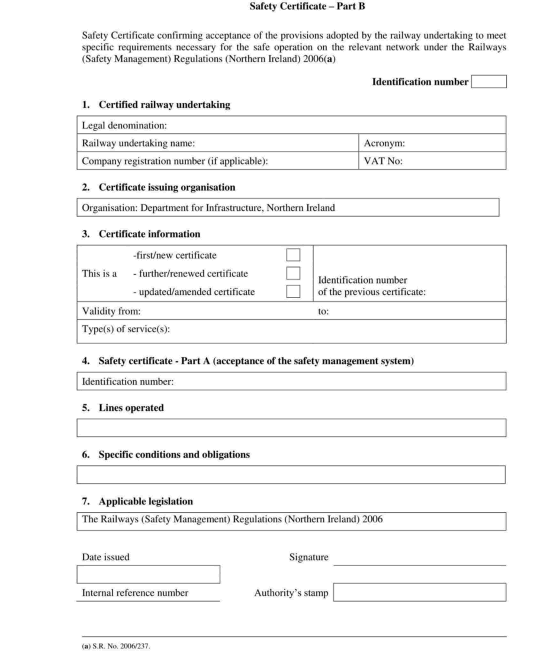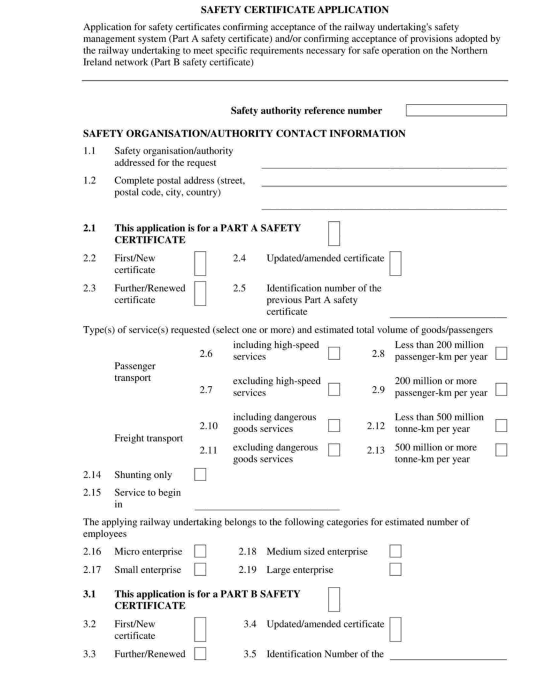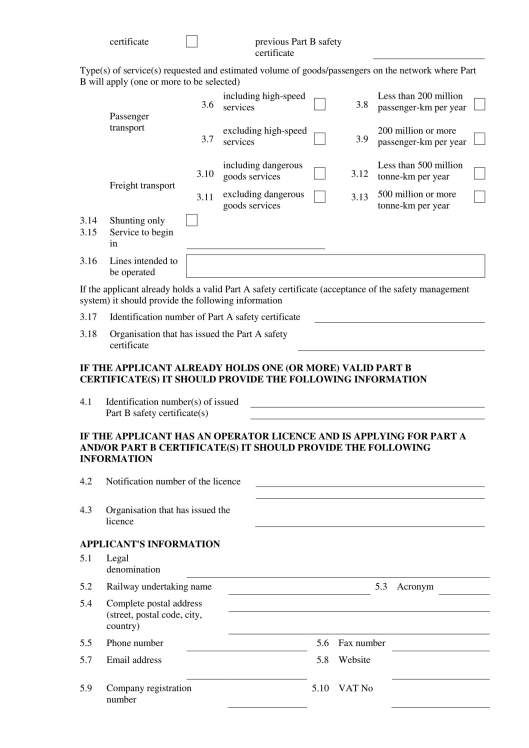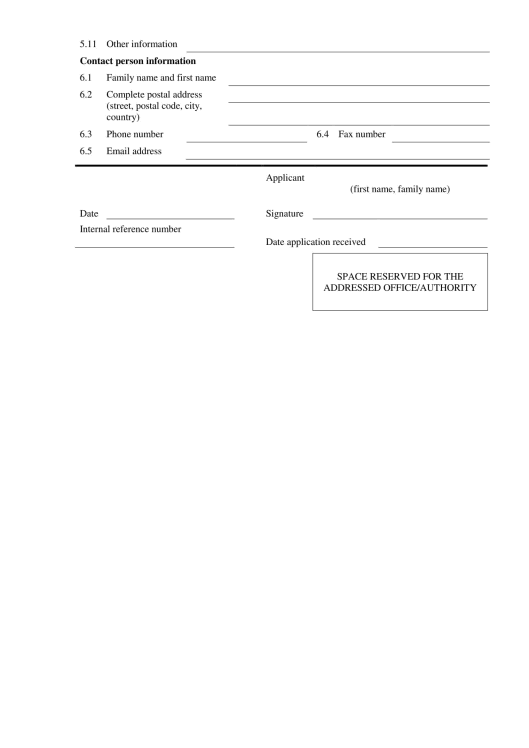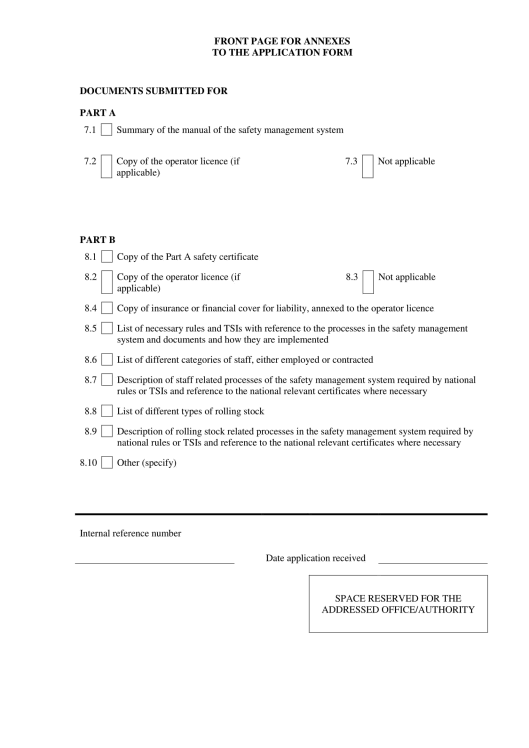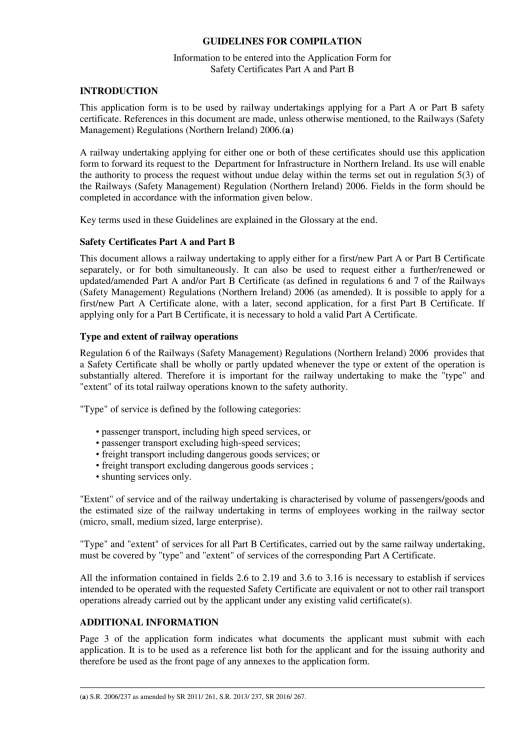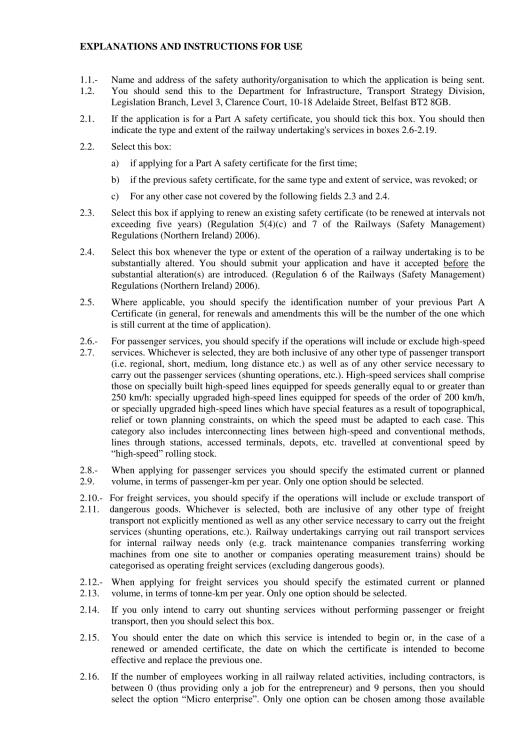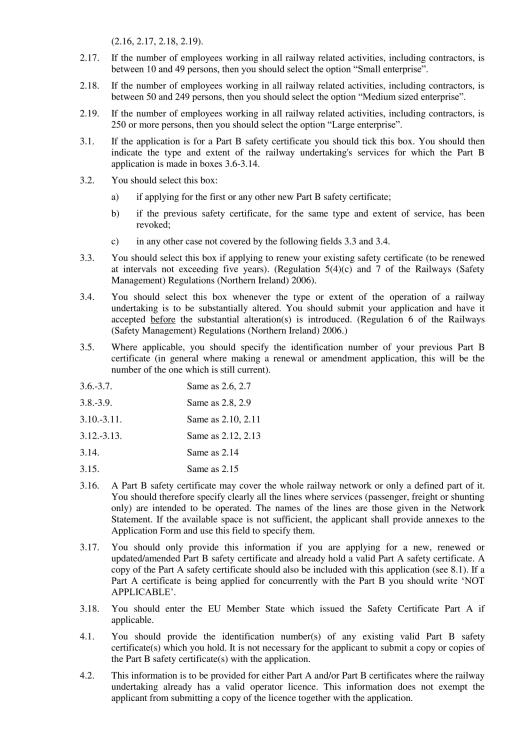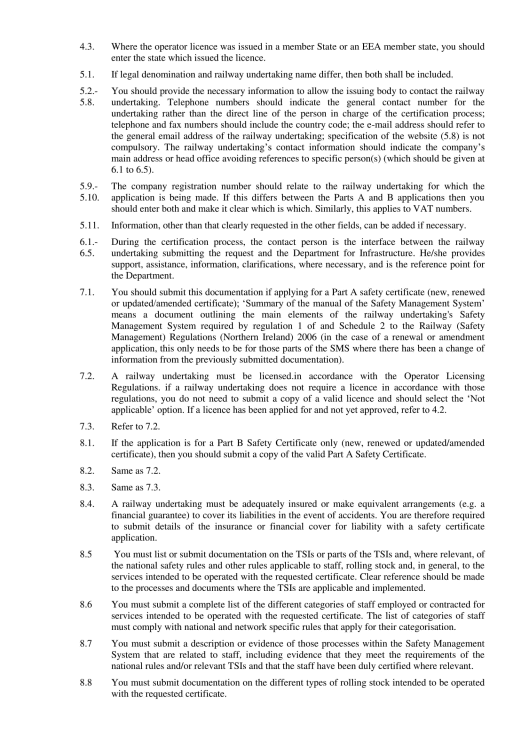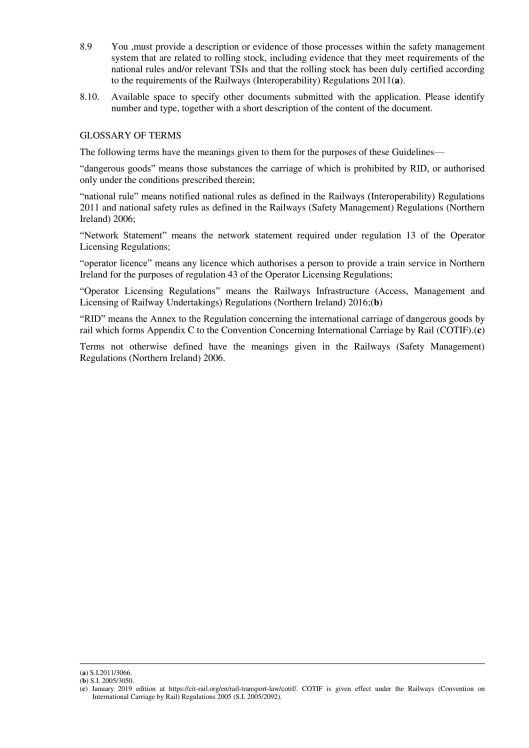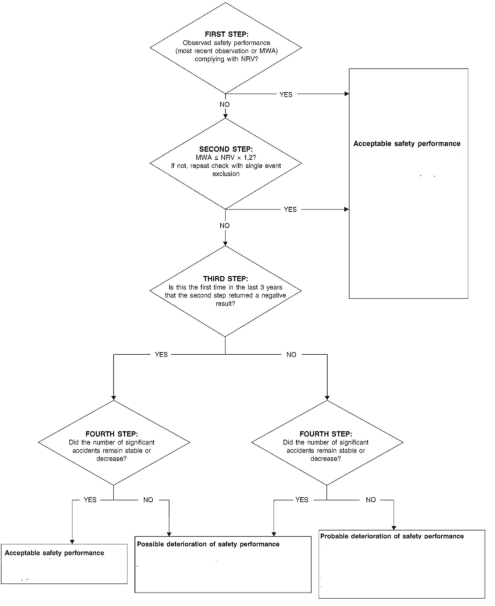- Latest available (Revised)
- Original (As made)
The Railways (Safety Management) (Amendment) (EU Exit) Regulations (Northern Ireland) 2019
You are here:
- UK Statutory Instruments
- 2019 No. 825
- Whole Instrument
- Previous
- Next
More Resources
Status:
This is the original version (as it was originally made).
This Statutory Instrument has been printed in substitution of the SI of the same number and is being issued free of charge to all known recipients of that Statutory Instrument.
Statutory Instruments
2019 No. 825
Exiting The European Union, Northern Ireland
Health And Safety, Northern Ireland
Transport, Northern Ireland
The Railways (Safety Management) (Amendment) (EU Exit) Regulations (Northern Ireland) 2019
Approved by both Houses of Parliament
Made
5th April 2019
Laid before Parliament
8th April 2019
Coming into force in accordance with regulation 1(2)
The Secretary of State makes these Regulations in exercise of the powers conferred by section 8(1) of, and paragraph 21 of Schedule 7 to, the European Union (Withdrawal) Act 2018(1).
The Secretary of State is of the opinion that, by reason of urgency, it is necessary to make these Regulations without a draft of the instrument being laid before, and approved by a resolution of, each House of Parliament.
Citation, commencement and extent
1.—(1) These Regulations may be cited as the Railways (Safety Management) (Amendment) (EU Exit) Regulations (Northern Ireland) 2019.
(2) These Regulations come into force on exit day.
(3) These Regulations extend to Northern Ireland only.
Amendment to the Railways (Safety Management) Regulations (Northern Ireland) 2006
2.—(1) The Railways (Safety Management) Regulations (Northern Ireland) 2006(2) are amended as follows.
(2) In regulation 2 (interpretation), paragraph (1)—
(a)for the definition of “common safety targets” (“CSTs”)”, substitute—
““common safety targets” (“CSTs”) means the minimum safety levels as set out in paragraph 17 of Schedule 7, that must be reached by the railway system, or parts of the railway system, expressed in risk categories as defined in paragraph 2 of Schedule 7;”;
(b)for the definition of “Department”, substitute—
““Department” means the Department for Infrastructure established by article 3(1) of the Departments (Northern Ireland) Order 1999(3) and renamed by section 1(6) of the Departments Act (Northern Ireland) 2016(4);)”;
(c)omit the definition of “European Railway Agency”;
(d)after the definition of “new”, insert—
““Office of Rail and Road” means the body established by section 15 of the Railways and Transport Safety Act 2003(5) and renamed by the Office of Rail Regulation (Change of Name) Regulations 2006(6);”;
(e)for the definition of “safety authority”, substitute—
““safety authority” means—
as regards a member State of the European Union, the authority established in that State in accordance with article 16.1 of the Directive;
as regards Great Britain, the Office of Rail and Road;
as regards Northern Ireland, the Department;”;
(3) After regulation 7 (further safety certificate), insert—
“Format for safety certificates and applications
7A. Schedule 6 (format for safety certificates and applications) has effect.”
(4) In regulation 13(5)(b), for “another Member State”, substitute “a member State of the European Union”.
(5) In regulation 16 (notification to the European Railway Agency regarding safety certificates and safety authorisations relating to the railway system) and in the heading that precedes it, for “European Railway Agency” substitute “Office of Rail and Road”.
(6) In regulation 18—
(a)in paragraph (3), for “European Railway Agency”, substitute “Office of Rail and Road”;
(b)for paragraph (4) substitute—
“(4) Annual reports for each calendar year must be sent to the Office of Rail and Road by 30th September in the year following the calendar year to which the report refers.”;
(c)in paragraph (5), for “European Railway Agency”, substitute “Office of Rail and Road”.
(7) After regulation 18 (annual safety reports) insert—
“Common safety targets
18A. The Department must assess the achievement of common safety targets in accordance with Schedule 7 (common safety targets).”.
(8) In Schedule 2 (application for a safety certificate), in paragraph 1(b)(i), for “in another member State or in Great Britain under provisions giving effect to article 10(2)(a) of the Directive” substitute “in a member State of the European Union or in Great Britain”.
(9) The Schedule has effect.
Signed by authority of the Secretary of State for Transport
Sugg
Parliamentary Under Secretary of State
Department for Transport
5th April 2019
Regulation 2(9)
SCHEDULESchedules to be inserted in the Railways (Safety Management) Regulations (Northern Ireland) 2006
1. After Schedule 5 to the Railways (Safety Management) Regulations (Northern Ireland) 2006, insert—
Regulation 7A
“SCHEDULE 6Format for safety certificates and applications
(This Schedule substantially reproduces the provisions of Commission Regulation (EC) No 653/2007 on the use of a common European format for safety certificates and application documents in accordance with Article 10 of Directive 2004/49/EC of the European Parliament and of the Council and on the validity of safety certificates delivered under Directive 2001/14/E, with amendments for the purposes of addressing deficiencies arising out of the UK’s withdrawal from the EU.)
PART 1
1. Where Part A of a safety certificate is to be issued, renewed, updated, amended or revoked, the Department must use the form provided in Part 2.
2. Where Part B of a safety certificate is to be issued, renewed, updated, amended or revoked, the Department must use the form provided in Part 3.
3. An application for a new, updated, amended or renewed—
(a)Part A of a safety certificate;
(b)Part B of a safety certificate; or
(c)Parts A and Part B of a safety certificate where a combined application is made,
must be made in the form provided in Part 4.
PART 2Part A of a safety certificate
4. The form referred to in paragraph 1 follows.
PART 3Part B of a safety certificate
5. The form referred to in paragraph 2 follows.
PART 4Application form for a safety certificate
6. The form referred to in paragraph 3 follows.
Regulation 18A
SCHEDULE 7Common safety targets
Application
1. This Schedule applies to the railway system(7).
Interpretation
2. In this Schedule—
“accident” means an unwanted or unintended sudden event or a specific chain of such events which have harmful consequences; accidents are divided into the following categories: collisions, derailments, level-crossing accidents, accidents to persons caused by rolling stock in motion, fires and others;
“fatalities and weighted serious injuries” (“FWSIs”) means a measurement of the consequences of significant accidents combining fatalities and serious injuries, where 1 serious injury is considered statistically equivalent to 0.1 fatalities;
“level crossing users” means all persons using a level crossing to cross a railway line by any means of transportation or by foot;
“national reference value” (“NRV”) means a reference measure indicating the maximum tolerable level for a railway risk category;
“others” means all persons who are not passengers, staff or employees including the staff of contractors, level crossing users, or unauthorised persons on railway premises;
“passenger-km” means the unit of measure representing the transport of one passenger by rail over a distance of one kilometre;
“passenger train-km” means the unit of measure representing the movement of a passenger train over one kilometre;
“risk category” means one of the railway risk categories specified by Article 7(4)(a) and (b) of the Directive;
“risk to whole” means the collective risk to all categories of persons listed in Article 7(4)(a) of the Directive;
“safety enhancement plan” means a plan to implement the organisational structure, responsibilities, procedures, activities, capabilities and resources required to reduce the risk for one or more risk categories;
“staff” or “employees including the staff of contractors” means any persons whose employment is in connection with a railway and is at work at the moment of the accident; it includes the crew of the train and persons handling rolling stock and infrastructure installations;
“track-km” means the length measured in kilometres of the railway network where each track of a multiple track railway line is to be counted;
“train-km” means the unit of measure representing the movement of a train over one kilometre; the distance used is the distance actually run, if available, otherwise the standard network distance between the origin and destination must be used;
“unauthorised persons on railway premises” means any persons present on railway premises where such presence is forbidden, with the exception of level crossing users.
Measurement units for NRVs and CSTs
3. The measurement units for NRVs must be expressed in compliance with the mathematical definition of risk. The consequences of accidents which must be considered for each of the risk categories are the FWSIs.
4. For the purpose of assessment of achievement of the NRVs for the passenger and level crossing user risk categories, compliance with one or both of these NRVs must be considered sufficient.
Principles for the assessment of achievement of NRVs and CSTs
5. The following principles apply for assessing achievement of NRVs and CSTs—
(a)for each risk category for which the NRV is equal to or lower than the corresponding CST, the achievement of the NRV also implies the achievement of the CST;
(b)the assessment of achievement of the NRV must be carried out according to the procedure described in paragraph 8 and the NRV represents the maximum tolerable level of the risk to which it refers, without prejudice to provisions of the range of tolerance laid down in paragraph 10;
(c)for each risk category for which the NRV is higher than the corresponding CST, the CST represents the maximum tolerable level of the risk to which it refers;
(d)the assessment of achievement is to be carried out in compliance with the requirements deriving from the impact assessment.
6. The assessment of achievement of the NRVs and CSTs must be carried out annually by the Department for Infrastructure, taking into consideration the most recent four preceding reporting years, including those years in which the assessment of achievement of the NRVs and CSTs in the United Kingdom was conducted by the European Railway Agency.
7. The outcome of the assessment of achievement referred to in paragraph 5 is to be classified as follows—
(a)acceptable safety performance;
(b)possible deterioration of safety performance; or
(c)probable deterioration of safety performance,
and published by the Department for Infrastructure.
Procedure for assessment of achievement of NRVs and CSTs
8. The procedure for the assessment of achievement of NRVs is composed of four different steps as described in the following paragraphs. The overall decisional flowchart of the procedure is shown in paragraph 15, where positive and negative decisional arrows correspond respectively to a ‘passed’ and a ‘failed’ result of the different assessment steps.
9.—(1) The first assessment step must verify whether the observed safety performance is complying with the NRV or not.
(2) The observed safety performance must be measured by using the measurement units listed in paragraph 14 and data gathered by the Department for Infrastructure in respect of railway accidents and related consequences, with time series which must include the most recent years of observations as specified in paragraph 6.
(3) The observed safety performance must be expressed in terms of:
(a)safety performance in the single most recent reported year; and
(b)moving weighted average (MWA), as specified in paragraph 13.
(4) The values returned must be compared with the NRV, and if one of these values does not exceed the NRV the safety performance must be considered acceptable. If this is not the case, the procedure must continue with the second assessment step.
10.—(1) The second assessment step shall deem the safety performance acceptable if the MWA does not exceed the NRV plus a 20% range of tolerance.
(2) If this condition is not satisfied, the Department for Infrastructure must obtain the specifics of the single highest-consequence accident, in terms of FWSIs, in the most recent years of observation as referred to in paragraph 6, excluding the years used to set the NRV.
(3) If this single accident is more severe, in terms of consequences, than the most severe single accident included in the data used for setting the NRV, it must be excluded from the statistics.
(4) The MWA is then recalculated to check whether it lies within the above-mentioned range of tolerance. If this is the case, the safety performance must be considered acceptable. If this is not the case, the procedure must continue with the third assessment step.
11. The third assessment step must verify whether it is the first time in the last 3 years that the second assessment step did not return evidence of acceptable safety performance. If this is the case, the outcome of the third assessment step must be classified as ‘passed’. The procedure must continue with the fourth step, whatever the outcome of the third step may be.
12.—(1) The fourth assessment step must verify whether the number of significant accidents per train-km, with respect to the previous years, remained stable (or decreased). The criteria for this appraisal are whether there has been a statistically significant increase in the number of relevant significant accidents per train-km. This must be evaluated by using an upper Poisson tolerance band which will determine the acceptable variability based on the number of accidents that occurred in the member States of the European Union.
(2) If the number of significant accidents per train-km does not exceed the abovementioned tolerance band, it is assumed that there has not been a statistically significant increase, and the outcome of this assessment step shall be classified as passed.
(3) Depending on the risk category to which the different NRVs under assessment of achievement refer, the significant accidents to be considered for carrying out this assessment step are as follows—
(a)risks to passengers: all relevant significant accidents;
(b)risks to staff or employees, including the staff of contractors: all relevant significant accidents;
(c)risks to level crossing users: all relevant significant accidents included in the risk category of level crossing accidents;
(d)risks to unauthorised persons on railway premises: all relevant significant accidents included in the risk category of accidents to persons caused by rolling stock in motion;
(e)risks to others: all relevant significant accidents;
(f)risk to society as a whole: all significant accidents.
Moving weighted averaging process for the annual assessment of achievement of NRVs
13. For each of the risk categories to which the MWA is applied for carrying out in each year Y (starting from Y = 2010), the assessment steps described in paragraphs 9 to 12, the following phases must be applied for calculating the MWAY
(a)calculation of the annual observations OBSi returned by the corresponding indicators in paragraph 14 after providing as input the relevant data for the relevant years;the index i takes the values as defined in the formula in sub paragraph (e);
(b)calculation of the 5-year average (AV) of annual observation OBSi;
(c)calculation of the absolute value of the difference ABSDIFFi between each annual observation OBSi and the AV. If ABSDIFFi < * 0.01 AV, the ABSDIFFi is attributed a constant value equal to 0.01* AV;(8)
(d)calculation of the weight Wi by taking the inverse of ABSDIFFi;
(e)calculation of the MWAY as follows—
where i is a natural number and x = Y – 6; N = Y – 2.
Measurement units for NRVs and CSTs
14. The following table sets out the measurement units for NRVs and CSTs.
| Risk category | Measurement units | Scaling bases |
|---|---|---|
| 1. Passengers | 1.1 Number of passenger FWSIs per year arising from significant accidents/Number of passenger train-km per year | Passenger train-km per year |
| 1.2 Number of passenger FWSIs arising from significant accidents/Number of passenger-km per year | Passenger-km per year | |
| 2. Employees | 2. Number of employee FWSIs per year arising from significant accidents/Number of train-km per year | Train-km per year |
| 3. Level crossing users | 3.1 Number of level-crossing user FWSIs per year arising from significant accidents/Number of train-km per year | Train-km per year |
| 3.2 Number of level-crossing user FWSIs per year arising from significant accidents/[(Number of Train-km per year x Number of level crossings)/Track-km)] | (Train-km per year x Number of level crossings)/Track-km | |
| 4. Others | 4. Yearly number of FWSIs to persons belonging to the category ‘others’ arising from significant accidents/Number of train-km per year | Train-km per year |
| 5. Unauthorised persons on railway premises | 5. Number of FWSIs to unauthorised persons on railway premises per year arising from significant accidents/Number of train-km per year | Train-km per year |
| 6. Whole society | 6. Total number of FWSIs per year arising from significant accidents/Number of train-km per year | Train-km per year |
Decision flowchart
15. The flowchart referred to in paragraph 8 is as follows—
Values for NRVs
16. The following table sets out the values of the NRVs for the purposes of this Schedule.
| NRV | Risk category | Value |
|---|---|---|
| 1.1 (x 10-9) | Risk to passengers | 2.73 |
| 1.2 (x 10-9) | 0.028 | |
| 2 (x 10-9) | Risk to employees | 5.17 |
| 3.1 (x 10-9) | Risk to level crossing users | 23.5 |
| 3.2 | n/a | |
| 4 (x 10-9) | Risk to persons classified as others | 7.00 |
| 5 (x 10-9) | Risk to unauthorised persons on railway premises | 84.5 |
| 6 (x 10-9) | Societal risk | 120.0 |
Values for CSTs
17. The following table sets out the values for the CSTs.
| Risk category | CST value (x 10-6) | Measurement units | |
|---|---|---|---|
| Risk to passengers | CST. 1.1 | 0.17 | Number of passenger FWSIs per year arising from significant accidents/Number of passenger train-km per year |
| CST 1.2 | 0.00165 | Number of passenger FWSIs arising from significant accidents/Number of passenger-km per year | |
| Risk to employees | CST 2 | 0.0779 | Number of employee FWSIs per year arising from significant accidents/Number of train-km per year |
| Risk to level crossing users | CST 3.1 | 0.710 | Number of level-crossing user FWSIs per year arising from significant accidents/Number of train-km per year |
| CST 3.2 | n/a | Number of level-crossing user FWSIs per year arising from significant accidents/[(Number of Train-km per year x Number of level crossings)/Track-km)] | |
| Risk to others | CST 4 | 0.0145 | Yearly number of FWSIs to persons belonging to the category ‘others’ arising from significant accidents/Number of train-km per year |
| Risk to unauthorised persons on railway premises | CST 5 | 2.05 | Number of FWSIs to unauthorised persons on railway premises per year arising from significant accidents/Number of train-km per year |
| Risk to society as a whole | CST 6 | 2.59 | Total number of FWSIs per year arising from significant accidents/Number of train-km per year” |
EXPLANATORY NOTE
(This note is not part of the Regulations)
These Regulations are made in exercise of the powers conferred by section 8(1) of, and paragraph 21 of Schedule 7 to, the European Union (Withdrawal) Act 2018 (c. 16) in order to address failures of retained EU law to operate effectively and other deficiencies (in particular under section 8(2)(a), (d) and (g)) arising from the withdrawal of the UK from the European Union.
These Regulations make amendments to the Railways (Safety Management) Regulations (Northern Ireland) 2006, particularly in relation to safety certification and authorisation and the use of common safety targets.
An impact assessment has not been produced for this instrument as no, or no significant, impact on the private or voluntary sector is foreseen. An Explanatory Memorandum has been produced for this instrument and is published alongside this instrument at www.legislation.gov.uk.
S.R. 2006 No. 237, amended by 2011 No. 261, 2013 No. 237, 2016 No. 267.
2016 c. 5 (N.I.). The Department for Infrastructure was originally established as the Department for Regional Development by article 3(1) of the Departments (Northern Ireland) Order 1999 (S.I. 1999/283) and subsequently renamed by subsection 1(6) of the Departments Act (Northern Ireland) 2016 (c. 5).
This Schedule substantially reproduces the provisions of Commission Decision 2009/460/EC on the adoption of a common safety method for assessment of achievement of safety targets, Commission Decision 2012/226/EU on the second set of common safety targets as regards the rail system, and the Commissioning Implementing Decision 2013/753/EU amending Decision 2012/226/EU on the second set of common safety targets for the rail system, in so far as they continue to have effect in Northern Ireland following the withdrawal of the United Kingdom from the European Union.
Asterisks in this paragraph have been used to indicate multiplication signs.
Options/Help
Print Options
PrintThe Whole Instrument
Legislation is available in different versions:
Latest Available (revised):The latest available updated version of the legislation incorporating changes made by subsequent legislation and applied by our editorial team. Changes we have not yet applied to the text, can be found in the ‘Changes to Legislation’ area.
Original (As Enacted or Made): The original version of the legislation as it stood when it was enacted or made. No changes have been applied to the text.
Explanatory Memorandum
Explanatory Memorandum sets out a brief statement of the purpose of a Statutory Instrument and provides information about its policy objective and policy implications. They aim to make the Statutory Instrument accessible to readers who are not legally qualified and accompany any Statutory Instrument or Draft Statutory Instrument laid before Parliament from June 2004 onwards.
More Resources
Access essential accompanying documents and information for this legislation item from this tab. Dependent on the legislation item being viewed this may include:
- the original print PDF of the as enacted version that was used for the print copy
- lists of changes made by and/or affecting this legislation item
- confers power and blanket amendment details
- all formats of all associated documents
- correction slips
- links to related legislation and further information resources
More Resources
Use this menu to access essential accompanying documents and information for this legislation item. Dependent on the legislation item being viewed this may include:
- the original print PDF of the as made version that was used for the print copy
- correction slips
Click 'View More' or select 'More Resources' tab for additional information including:
- lists of changes made by and/or affecting this legislation item
- confers power and blanket amendment details
- all formats of all associated documents
- links to related legislation and further information resources
